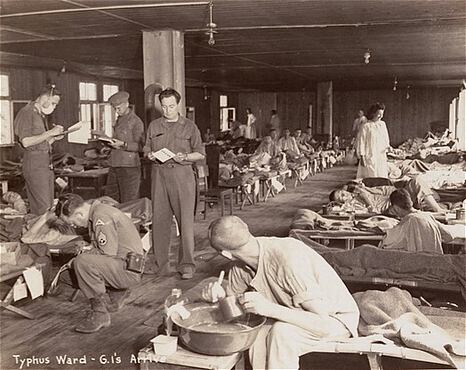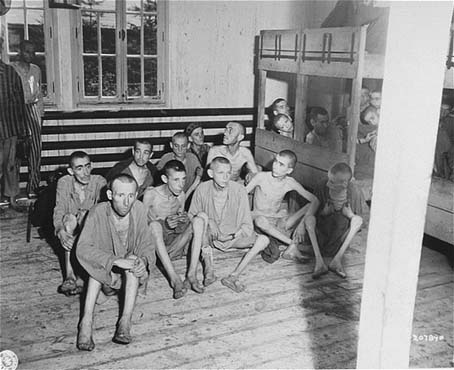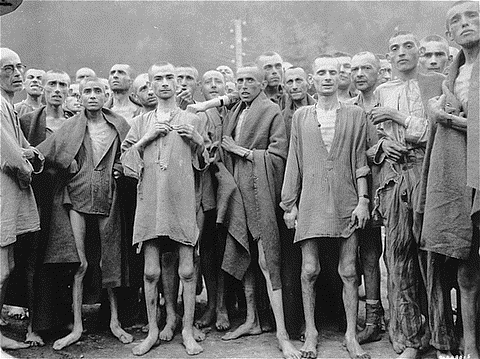Medicine in Auschwitz
The book Nazi Medicine: Doctors, Victims and Medicine in Auschwitz
by Howard Fertig explores the role of medicine and those affected by it in
the Auschwitz concentration camp. The book is divided up into three
parts: the experiments, the doctor's stories, and the camps after the end
of the war. I will focus on the experimental medicine (part one) in
this project. More specifically I will discuss the new experimental
medicine used to fight typhus, along with experimental typhus and the main
doctor who carried out these medicinal experiments; Dr. Helmuth Vetter.
A quick biography on Dr. Helmuth Vetter tells that he was born on February
21, 1910 in Rastenburg, Turingen. He was camp physician in Auschwitz
and was also an agent of the "Bayer" firm from the Hochst-Leverkusen laboratories.
While in Auschwitz he conducted experiments in block 20 [the contagious diseases
ward] from 1942 - 1944. More specifically he conducted research on Preparation
3582, Ruthenol and Periston for experimental purposes regarding typhus, typhoid
fever, paratyphoid diseases, diarrhea, tuberculosis of the lungs, erysipelas,
and scarlet fever.
Dr. Vetter would choose patients with the said diseases in various stages.
The patients were administered various doses of medicine for the same disease to
check the toxic levels of such medicine. In each case detailed case
histories and results were kept and the book uses this evidence greatly; often
putting in the actual document for the reader to make his own mind up about
it. The patients were called Versuchsreihe - "experimental group".
Also, the patients were refused any other medicine than that prescribed.
Vetter used between 150 and 250 patients in his experiments. A high
percentage of the patients died. The purposes of the pharmacological
experiments were not in the hopes of helping the patients but to observe the
reaction of the medicine on the patients even when it was obvious that the
medicine was harmful to the patient.

(typhus
ward)
Now that a quick overview has been shown, we can get to the main focus of this
paper; the medicines preparation 3582 and Periston on typhus and the role of
experimental typhus. The facts used are directly from the original
documents kept by the doctors and all the opinions stated are what I made after
reading the actual documents; I did not use patients' opinions as there a chance
they might be biased in some way. The experimental preparation 3582 was
used on 50 prisoners with typhus. The patients started "treatment" as soon
as typhus was noticed. The patients were treated for 5 days; they were
given 2 tablets 3 times a day. The patients had bad reactions to the
tablets, so they were given the same dosage dissolved in half a liter of
water. This method caused heavy vomiting which weakened the patients
significantly. Next, the patients were given the medicine in the form of
an enema. This method caused violent and painful diarrhea up to 15 times a
day. Patients did best with 2 tablets at a time, 3 times a day with lots
of water. The medicine caused bitterness and burning on the tongue and
pallet. The medicine of the day consisted of 3 grams a day for a total of
15 grams. Here are some statistics of the reactions to the
medicine:
-
2 cases of swelling of the lips.
-
79% of patients vomited after taking the pill.
-
33% experienced sporadic diarrhea.
-
15 patients died due to the immediate effects of the medicine
o 6
died due to weakening of the heart muscle.
o 6
died due to toxic after effects.
o 2
died because of brain complications [myelitis and encephalitis]
o 1
died due to fever.
-
The 35 surviving patients experienced a drop in temperature but other
symptoms of typhus remained.
-
3 patients died due to the rapid drop in temperature.

(patients
in the infirmary)
In light cases of typhus the typhus spots disappeared 4 - 5 days after the drop
in temperature. During the duration of the medicine an easing of
headaches, pains of the joints and muscles were observed. However, the
dryness of the tongue and palate remained. The medicine caused an overall
weakening of the heart muscle and on the 6th day the pulse weakened
and blood pressure was substantially lowered. The spleen and liver became
swollen. However, this remained with and without the preparation
3582. Also, the medicine caused a weakening of sight and hearing. In
conclusion, although the medicine caused a drop in temperature and got rid of
the fever, it did little to nothing in curing typhus.
Another experimental medicine used on typhus patients by Dr. Helmuth Vetter was
Periston. Periston was administered intravenously for patients suffering
from typhus. Periston was the only medicine that in some cases has a
soothing effect on typhus. The Periston was heated up to 40 degrees
Celsius then given to the patients in dosages of 2 cubic centimeters a
day. Periston was tested on five patients and caused no negative effects
on the human organisms. The medicine caused a general improvement of
feeling to the patient. However, Periston has no influence on the duration
of the disease or typhus spots. Periston was helpful in causing the
disappearance of the dryness of the tongue, the mucous membranes of the oral
cavity and larynx. Periston helped take away headaches and counteracted
the inflammation of the organs and helped increase the patient's blood
pressure. Lastly, Periston helped reduced the normal drop of weight typhus
caused. So overall, Periston did not help with typhus at all but it did
make the patient feel better and soothe them.
Lastly, Dr. Vetter experimented with typhus itself. Patients would be
injected with the blood of a typhus infected inmate in the hopes of finding out
how to vaccinate German soldiers from typhus.
Three
types of prisoners were used:
o
Criminal Prisoners: were not seen as a big loss.
o
Volunteers: if the managed to live they would get to live in the
infirmary for three months [had better beds, more food, etc].
o
Political Prisoners: used against their will and seen as nothing more
than "guinea pigs".
Blood was taken from a victim suffering of spontaneous typhus and injected into
a healthy patient. The experiment hoped to learn the incubation period of
typhus, the course of the disease, and the effects of certain medicines on the
disease. 19 people from Block 46 [the data managed to be saved from this
block] were infected with typhus. Patients were infected with typhus after
it had been active for five days. Rashes appeared around the
3rd day and cardiovascular collapse [hypotension, hollow heart sounds
and murmurs] occurred in 11 of the 14 cases. The spleen was also inflamed
in all the cases. 10 patients died and 4 were cured. Cardiovascular
collapse was the frequent cause of death. Patients died between the
8th and 9th day and the mortality rate was higher than in
cases of spontaneous typhus. There was a large increase in the number of
leucocytes. Nothing was learned from the experiments with typhus and in
all many prisoners lost their lives.
In Auschwitz experimental medicine was tried by doctors (namely Dr. Helmuth
Vetter) on sick patients, mostly typhus. However, even when it was obvious
the patient was being hurt, the experiment would continue. Many patients
lost their lives and few were saved. Even worse, the experiments were not
trying to cure the patients but to see bodily reactions to the disease and
different medicine.

(survivors from the
medical ward)
In conclusion, by carrying out these experiments and trying them on inmates in
the camps, the Nazi physicians broke their Hippocratic Oath (stated in the
Introduction) that had been put in place and followed for almost two thousand
years. They not only broke their promise as a doctor but they killed and
injured many innocent prisoners for the simple reason of wanting to find out how
individuals would react to different amounts and types of medicines.
Bibliography:
Fertig, Howard.
Nazi Medicine: Doctors, Victims and Medicine in
Auschwitz. Howard Fertig Inc., New York. 1986.
Pictures taken
from:
http://fcit.coedu.usf.edu/holocaust/RESOURCE/GALLERY/gallery.htm